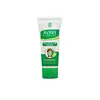What's inside
What's inside
 Key Ingredients
Key Ingredients

 Benefits
Benefits

 Concerns
Concerns

 Ingredients Side-by-side
Ingredients Side-by-side

Water
Skin ConditioningButylene Glycol
HumectantBentonite
AbsorbentKaolin
AbrasiveGlycerin
HumectantTriethylhexanoin
MaskingTitanium Dioxide
Cosmetic ColorantIllite
AbrasiveMelaleuca Alternifolia Leaf Oil
AntioxidantPhenoxyethanol
PreservativeXanthan Gum
EmulsifyingPolysorbate 20
EmulsifyingDipotassium Glycyrrhizate
HumectantMethylparaben
PreservativeDisodium EDTA
Propylparaben
PreservativeAlcohol
AntimicrobialPEG-60 Almond Glycerides
EmulsifyingCaprylyl Glycol
EmollientAloe Barbadensis Leaf Extract
EmollientEthylparaben
PreservativeCarbomer
Emulsion StabilisingNordihydroguaiaretic Acid
AntioxidantOleanolic Acid
Skin ConditioningCI 42053
Cosmetic ColorantCI 19140
Cosmetic ColorantWater, Butylene Glycol, Bentonite, Kaolin, Glycerin, Triethylhexanoin, Titanium Dioxide, Illite, Melaleuca Alternifolia Leaf Oil, Phenoxyethanol, Xanthan Gum, Polysorbate 20, Dipotassium Glycyrrhizate, Methylparaben, Disodium EDTA, Propylparaben, Alcohol, PEG-60 Almond Glycerides, Caprylyl Glycol, Aloe Barbadensis Leaf Extract, Ethylparaben, Carbomer, Nordihydroguaiaretic Acid, Oleanolic Acid, CI 42053, CI 19140
Water
Skin ConditioningMontmorillonite
AbsorbentGlycerin
HumectantArtemisia Vulgaris Extract
Skin ConditioningCetearyl Alcohol
EmollientOryza Sativa Bran Oil
EmollientMethylpropanediol
SolventEthylhexyl Palmitate
EmollientCI 77891
Cosmetic ColorantMagnesium Aluminometasilicate
AbsorbentGlyceryl Stearate
EmollientVolcanic Soil
Skin ConditioningPEG-100 Stearate
Ceramide AP
Skin Conditioning1,2-Hexanediol
Skin ConditioningHydroxyacetophenone
AntioxidantXanthan Gum
EmulsifyingCetearyl Glucoside
EmulsifyingAllantoin
Skin ConditioningChlorphenesin
AntimicrobialNiacinamide
SmoothingCentella Asiatica Extract
CleansingCeramide As
Skin ConditioningCeramide EOP
Skin ConditioningSodium Hyaluronate
HumectantAlchemilla Vulgaris Extract
AstringentBisabolol
MaskingSilica
AbrasiveEthylhexylglycerin
Skin ConditioningDisodium EDTA
Pentylene Glycol
Skin ConditioningSophora Flavescens Root Extract
AntioxidantTrehalose
HumectantOpuntia Ficus-Indica Stem Extract
Skin ConditioningOphiopogon Japonicus Root Extract
Skin ConditioningHydrogenated Lecithin
EmulsifyingButylene Glycol
HumectantGlucose
HumectantLactobacillus Ferment
Skin ConditioningParfum
MaskingCeramide NP
Skin ConditioningZingiber Officinale Root Extract
MaskingPropylene Glycol
HumectantSalicylic Acid
MaskingGentiana Scabra Extract
HumectantAmylopectin
Dextrin
AbsorbentFomes Officinalis Extract
Skin ProtectingPyrus Malus Bark Extract
AstringentCeramide Ns
Skin ConditioningPropylparaben
PreservativeGlycyrrhiza Inflata Root Extract
Skin ConditioningRoyal Jelly Extract
Skin ConditioningCI 77492
Cosmetic ColorantWater, Montmorillonite, Glycerin, Artemisia Vulgaris Extract, Cetearyl Alcohol, Oryza Sativa Bran Oil, Methylpropanediol, Ethylhexyl Palmitate, CI 77891, Magnesium Aluminometasilicate, Glyceryl Stearate, Volcanic Soil, PEG-100 Stearate, Ceramide AP, 1,2-Hexanediol, Hydroxyacetophenone, Xanthan Gum, Cetearyl Glucoside, Allantoin, Chlorphenesin, Niacinamide, Centella Asiatica Extract, Ceramide As, Ceramide EOP, Sodium Hyaluronate, Alchemilla Vulgaris Extract, Bisabolol, Silica, Ethylhexylglycerin, Disodium EDTA, Pentylene Glycol, Sophora Flavescens Root Extract, Trehalose, Opuntia Ficus-Indica Stem Extract, Ophiopogon Japonicus Root Extract, Hydrogenated Lecithin, Butylene Glycol, Glucose, Lactobacillus Ferment, Parfum, Ceramide NP, Zingiber Officinale Root Extract, Propylene Glycol, Salicylic Acid, Gentiana Scabra Extract, Amylopectin, Dextrin, Fomes Officinalis Extract, Pyrus Malus Bark Extract, Ceramide Ns, Propylparaben, Glycyrrhiza Inflata Root Extract, Royal Jelly Extract, CI 77492
 Reviews
Reviews

Ingredients Explained
These ingredients are found in both products.
Ingredients higher up in an ingredient list are typically present in a larger amount.
Butylene Glycol (or BG) is used within cosmetic products for a few different reasons:
Overall, Butylene Glycol is a safe and well-rounded ingredient that works well with other ingredients.
Though this ingredient works well with most skin types, some people with sensitive skin may experience a reaction such as allergic rashes, closed comedones, or itchiness.
Learn more about Butylene GlycolDisodium EDTA plays a role in making products more stable by aiding other preservatives.
It is a chelating agent, meaning it neutralizes metal ions that may be found in a product.
Disodium EDTA is a salt of edetic acid and is found to be safe in cosmetic ingredients.
Learn more about Disodium EDTAGlycerin is already naturally found in your skin. It helps moisturize and protect your skin.
A study from 2016 found glycerin to be more effective as a humectant than AHAs and hyaluronic acid.
As a humectant, it helps the skin stay hydrated by pulling moisture to your skin. The low molecular weight of glycerin allows it to pull moisture into the deeper layers of your skin.
Hydrated skin improves your skin barrier; Your skin barrier helps protect against irritants and bacteria.
Glycerin has also been found to have antimicrobial and antiviral properties. Due to these properties, glycerin is often used in wound and burn treatments.
In cosmetics, glycerin is usually derived from plants such as soybean or palm. However, it can also be sourced from animals, such as tallow or animal fat.
This ingredient is organic, colorless, odorless, and non-toxic.
Glycerin is the name for this ingredient in American English. British English uses Glycerol/Glycerine.
Learn more about GlycerinPropylparaben is a preservative and is a paraben with antifungal and antimicrobial properties.
This ingredient can be naturally found in plants and insects, but most of it is synthetically manufactured for human use. In cosmetics, it is usually created by reacting para-aminobenzoic acid and propanol (an alcohol).
You can usually find this ingredient in water-based products.
Parabens have come under controversy due to the claim they are hormone disruptors. Studies show conflicting results. We recommend speaking with a professional if you have any concerns.
Propylparaben is commonly found in food, medicine, and cosmetics.
Learn more about PropylparabenWater. It's the most common cosmetic ingredient of all. You'll usually see it at the top of ingredient lists, meaning that it makes up the largest part of the product.
So why is it so popular? Water most often acts as a solvent - this means that it helps dissolve other ingredients into the formulation.
You'll also recognize water as that liquid we all need to stay alive. If you see this, drink a glass of water. Stay hydrated!
Learn more about WaterXanthan gum is used as a stabilizer and thickener within cosmetic products. It helps give products a sticky, thick feeling - preventing them from being too runny.
On the technical side of things, xanthan gum is a polysaccharide - a combination consisting of multiple sugar molecules bonded together.
Xanthan gum is a pretty common and great ingredient. It is a natural, non-toxic, non-irritating ingredient that is also commonly used in food products.
Learn more about Xanthan Gum